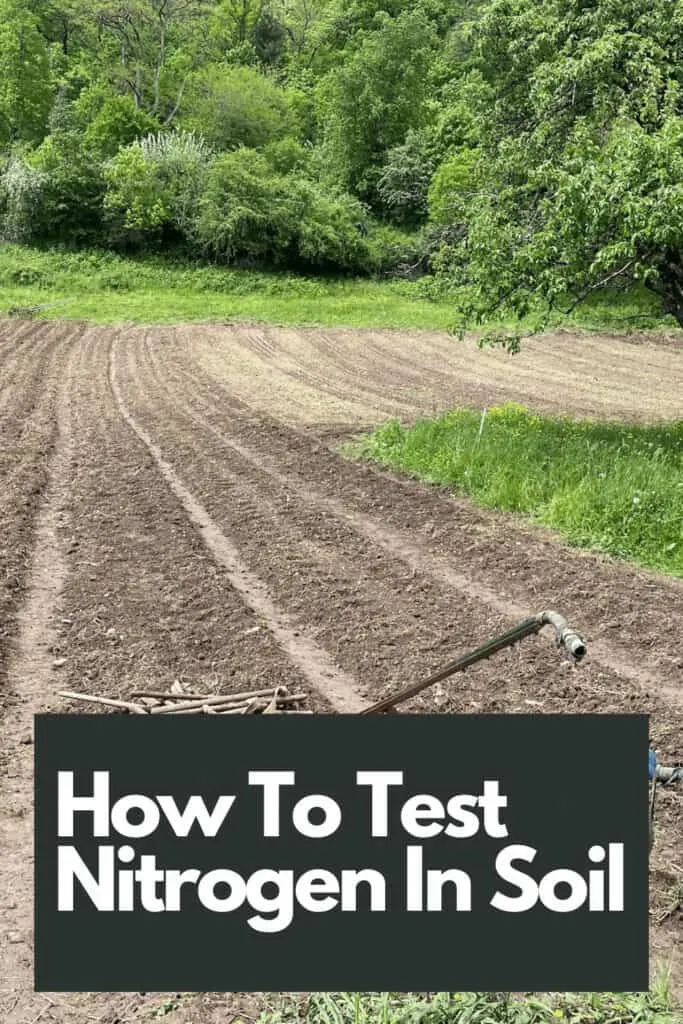How to test nitrogen in the soil. There are many components of soil, and each one needs to be present in certain quantities to grow a healthy vegetable crop or a beautiful garden.
One of these key nutrients is nitrogen, primarily responsible for bountiful, healthy flowers and plants.
Unfortunately, nitrogen can be lost in the soil either through leaching and denitrification, or it can be present at undesirably high levels.
Testing your soil‘s nitrogen levels and, if required, adding nitrogen back into the soil will make a major difference to the health and abundance of your garden.
If you’re wondering how to test for nitrogen in the soil, I’ve broken it down so you can make the best decision for your garden.
Table of Contents
How to Test for Nitrogen in Soil
The best way to test nitrogen in the soil is to hire a company that does soil tests. This is the most accurate way of testing nitrogen levels. You can also buy a home testing kit to test soil nutrients.

More About Nitrogen and Nitrogen Testing
If your garden is struggling, and you feel there may be a soil imbalance, it’s a good idea to check the nitrogen levels.
You should also know the signs of nitrogen deficiency and overabundance to help you troubleshoot and narrow down the issues your garden is facing.
Nitrogen deficiency signs are seen as yellowing leaves and slow growth, while an overabundance of nitrogen will present as excessive leaf growth with poor flowers or lack of budding.
These scenarios require testing and different treatment methods to achieve a healthy nitrogen balance.
Hiring a company to test your soil’s nitrogen level is an easy and accurate way to discover any problems, and it isn’t too expensive.
A company will usually test your soil for around $20, which is approximately the same price as a home test kit. If you want the DIY route, there are plenty of test kits available for home gardeners.
These usually won’t cost more than about $30 and can be found at your home garden store or online.
Home test kits offer readings in about 10 minutes, while a company takes 3-4 days to get the results back to you.
If nitrogen levels are low, you need to add nitrogen back into the soil, and you likely have the tools to do this right in your home with natural compost.
Banana peels, coffee grounds, and eggshells all release nitrogen. Simply mix it with your soil, which should help raise the levels.
If you don’t want to go the DIY route, a fertilizer should do the trick. Be sure to talk with the employees at a home garden store to ensure you purchase the right fertilizer for your problem.
Did your results come back showing that your soil has too much nitrogen? Mulching and leaching your garden is the easiest way to lift the nitrogen out and achieve a balanced level.
This works by pushing the nitrogen down deeper into the soil, so unless you have deep-rooted plants it should be further from the reach of their roots.
You will want to clear the excess debris in the surrounding area to leach your garden. After you’ve done this, soak the soil enough that it reaches a few inches below the surface.
You will want to keep the soil fully saturated at this depth for a few days in order to encourage nitrogen runoff.
After you’ve done this, test your soil again to see if this has helped remedy your nitrogen problem.
If your issue is nitrogen overabundance in your vegetable garden and leaching or mulching the soil didn’t work, certain vegetables are nitrogen lovers and will utilize the nitrogen found in the soil.
Cabbage, tomatoes, corn, and broccoli are a few different vegetable plants that can help with this.
However, please don’t overdo it and end up with a nitrogen deficiency.
Frequently Asked Questions
What are the signs of nitrogen imbalance?
Common signs of low nitrogen levels are yellowing leaves and slow plant growth, while an overabundance of nitrogen will cause a lot of leafy growth with poor budding. You can also observe your surrounding yard. If you notice that the grass isn’t growing back in areas that are frequently walked on, you may be looking at a nitrogen deficiency.
How to test for nitrogen in soil?
Nitrogen testing can be done at home or with a company. A home test kit will give you immediate results, whereas a company usually has a 3-4 day turnaround. Both have similar costs, so the deciding factor usually comes in time. No matter which one you choose, you will likely have your results back soon to start working on the issue in just a few days.
What do I do if my soil’s nitrogen levels are imbalanced?
If your soil’s nitrogen levels are too low, you must add nitrogen back through fertilizers or additives. If the levels are too high, you must mulch your garden to encourage nitrogen reduction. Make sure to look for fertilizers and other soil additives that are specifically designed to help balance your soil’s nitrogen levels.
Testing for Nitrogen in Soil
As you can see, an overabundance or a lack of nitrogen in your soil can cause many issues. While initially sounds complicated, testing for nitrogen in your soil is very simple.
These easy steps can help you troubleshoot the exact cause of your garden’s problems and ensure that you achieve a beautiful garden that will last for many seasons.

Daniel has been a plant enthusiast for over 20 years. He owns hundreds of houseplants and prepares for the chili growing seasons yearly with great anticipation. His favorite plants are plant species in the Araceae family, such as Monstera, Philodendron, and Anthurium. He also loves gardening and is growing hot peppers, tomatoes, and many more vegetables.


